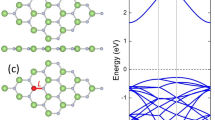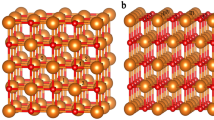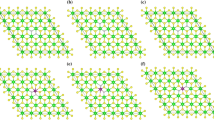Abstract
Alkaline earth halides garnered interest in spintronics research due to their longer spin relaxation time. Employing first principles calculations, 3d transition metal (TM)-substituted magnesium bromide (MgBr2) monolayers have been reported for the first time for potential spintronics applicability. Among these systems, Cr-, Cu- and Fe-substituted MgBr2 monolayers showed half-metallicity that can be used in ultra-fast spintronics because of high spin polarization. Bipolar magnetic semiconducting (BMS) nature was observed in Mn-substituted monolayer that enables spin control and manipulation by external bias voltage. The formation energy of TM dopants under Br-rich condition showed the feasibility of TM substitution. The half-metallic TM-substituted systems showed a large spin channel gap which inhibits spin leakage. The spin flip gap in BMS monolayer was feasible for practical device operation. Additionally, significant magnetic anisotropy energy per dopant has been observed with a ferromagnetic coupling in Cr-, Cu- and Fe-substituted systems, while antiferromagnetic coupling was shown by Mn- and V-substituted monolayers. Monte Carlo (MC) simulation revealed a near room temperature magnetic phase transition temperature. Robustness of the half-metallicity and BMS spin flip gap was ascertained with strain-mediated density of states which is of importance while fabrication upon a lattice mismatch between substrate. The magnetic transition temperature tuned by applied either compressive or tensile strain is also performed. Hence, electronic and magnetic studies revealed 3d TM element-substituted monolayer MgBr2 to be a potential system in spintronics applications.
Graphical Abstract








Similar content being viewed by others
Explore related subjects
Discover the latest articles, news and stories from top researchers in related subjects.References
Guo Y, Deng H, Sun X et al (2017) Modulation of metal and insulator states in 2D ferromagnetic VS2 by van der Waals interaction engineering. Adv Mater 29:1700715. https://doi.org/10.1002/adma.201700715
Li X, Yang J (2016) First-principles design of spintronics materials. Natl Sci Rev 3:365–381. https://doi.org/10.1093/nsr/nww026
Sethulakshmi N, Mishra A, Ajayan PM et al (2019) Magnetism in two-dimensional materials beyond graphene. Mater Today 27(107–122):22. https://doi.org/10.1016/j.mattod.2019.03.015
Gong C, Li L, Li Z et al (2017) Discovery of intrinsic ferromagnetism in two-dimensional van der Waals crystals. Nature 546:265–269. https://doi.org/10.1038/nature22.22060
Huang B, Clark G, Navarro-Moratalla E et al (2017) Layer-dependent ferromagnetism in a van der Waals crystal down to the monolayer limit. Nature 546:270–273. https://doi.org/10.1038/nature22.22391
Yu W, Li J, Herng TS et al (2019) Chemically exfoliated VSe2 monolayers with room-temperature ferromagnetism. Adv Mater 31:1903779. https://doi.org/10.1002/adma.201903779
Tong Q, Liu F, Xiao J, Yao W (2018) Skyrmions in the Moiré of van der Waals 2D magnets. Nano Lett 18:7194–7199. https://doi.org/10.1021/acs.nanolett.8b03315
Jorio A (2022) Twistronics and the small-angle magic. Nat Mater 21:844–845. https://doi.org/10.1038/s41563-022.22-01290-6
Wang J, Sun F, Yang S et al (2016) Robust ferromagnetism in Mn-substituted MoS2 nanostructures. Appl Phys Lett 109:092401. https://doi.org/10.1063/1.4961883
Li B, Xing T, Zhong M et al (2017) A two-dimensional Fe-substituted SnS2 magnetic semiconductor. Nat Commun 8:1–7. https://doi.org/10.1038/s41467-017-02077-z
Tiwari S, van de Put ML, Sorée B, Vandenberghe WG (2021) Magnetic order and critical temperature of substitutionally doped transition metal dichalcogenide monolayers. npj 2D Mater Appl 5:54. https://doi.org/10.1038/s41699-021-00233-0
Bhattacharyya G, Choudhuri I, Pathak B (2018) High Curie temperature and half-metallicity in an atomically thin main group-based boron phosphide system: long range ferromagnetism. Phys Chem Chem Phys 20:22877–22889. https://doi.org/10.1039/C8CP03440K
Lin SH, Kuo JL (2014) Towards the ionic limit of two-dimensional materials: monolayer alkaline earth and transition metal halides. Phys Chem Chem Phys 16:20763–20771. https://doi.org/10.1039/C4CP02048K
Sheha EM, Nasr MM, El-Mansy MK (2015) The role of MgBr2 to enhance the ionic conductivity of PVA/PEDOT:PSS polymer composite. J Adv Res 6:563–569. https://doi.org/10.1016/j.jare.2014.01.010
Salehi H, Guo Q (2004) A facile and efficient one-pot synthesis of dihydropyrimidinones catalyzed by magnesium bromide under solvent-free conditions. Synth Commun 34:171–179. https://doi.org/10.1081/SCC-120027250
Fairbrother DH, Roberts JG, Rizzi S, Somorjai GA (1997) Structure of monolayer and multilayer magnesium chloride films grown on Pd(111). Langmuir 13:2090–2096. https://doi.org/10.1021/la960680c
Novosad SS (1998) Scintillation characteristics of thin-film calcium iodide crystal x-ray detectors. Tech Phys 43:956–958. https://doi.org/10.1134/1.1259107
Zhu J, Schwingenschlögl U (2014) Band gap opening in silicene on MgBr2 (0001) induced by Li and Na. ACS Appl Mater Interfaces 6:19242–19246. https://doi.org/10.1021/am5052697
Wan J, Lacey SD, Dai J et al (2016) Tuning two-dimensional nanomaterials by intercalation: materials, properties and applications. Chem Soc Rev 45:6742–6765. https://doi.org/10.1039/C5CS00758E
Majd ZG, Taghizadeh SF, Amiri P, Vaseghi B (2019) Half-metallic properties of transition metals adsorbed on WS2 monolayer: a first-principles study. J Magn Magn Mater 481:129–135. https://doi.org/10.1016/J.JMMM.2019.01.063
Lima IT, Vasconcelos R, Gargano R, Paura ENC (2020) A first-principles study of the substitutional doping of the MgCl2monolayer for spintronics applications. New J Chem 44:8833–8839. https://doi.org/10.1039/d0nj01264e
Habib M, Muhammad Z, Khan R et al (2018) Ferromagnetism in CVT grown tungsten diselenide single crystals with nickel doping. Nanotechnology 29:115701. https://doi.org/10.1088/1361-6528/aaa63e
Jiang J, Zhang Q, Wang A et al (2019) A facile and effective method for patching sulfur vacancies of WS2 via nitrogen plasma treatment. Small 15:1901791. https://doi.org/10.1002/smll.201901791
Wi S, Kim H, Chen M et al (2014) Enhancement of photovoltaic response in multilayer MoS2 induced by plasma doping. ACS Nano 8:5270–5281. https://doi.org/10.1021/nn5013429
Giannozzi P, Baroni S, Bonini N et al (2009) Quantum espresso: a modular and open-source software project for quantum simulations of materials. J Phys Condens Matter 21:395502. https://doi.org/10.1088/0953-8984/21/39/395502
Perdew JP, Burke K, Ernzerhof M (1996) Generalized gradient approximation made simple. Phys Rev Lett 77:3865–3868. https://doi.org/10.1103/PhysRevLett.77.3865
Perdew JP, Chevary JA, Vosko SH et al (1992) Atoms, molecules, solids, and surfaces: applications of the generalized gradient approximation for exchange and correlation. Phys Rev B 46:6671–6687. https://doi.org/10.1103/PhysRevB.46.6671
Blöchl PE (1994) Projector augmented-wave method. Phys Rev B 50:17953–17979. https://doi.org/10.1103/PhysRevB.50.17953
Monkhorst HJ, Pack JD (1976) Special points for brillouin-zone integrations. Phys Rev B 13:5188–5192. https://doi.org/10.1103/PhysRevB.13.5188
Grimme S, Antony J, Ehrlich S, Krieg H (2010) A consistent and accurate ab initio parametrization of density functional dispersion correction (DFT-D) for the 94 elements H-Pu. J Chem Phys 132:154104. https://doi.org/10.1063/1.3382344
Billeter SR, Curioni A, Andreoni W (2003) Efficient linear scaling geometry optimization and transition-state search for direct wavefunction optimization schemes in density functional theory using a plane-wave basis. Comput Mater Sci 27:437–445. https://doi.org/10.1016/S0927-0256(03)00043-0
Li D, Barreteau C, Castell MR et al (2014) Out- versus in-plane magnetic anisotropy of free Fe and Co nanocrystals: tight-binding and first-principles studies. Phys Rev B Condens Matter Mater Phys 90:205409. https://doi.org/10.1103/PhysRevB.90.205409
He X, Helbig N, Verstraete MJ, Bousquet E (2021) TB2J: a python package for computing magnetic interaction parameters. Comput Phys Commun 264:107938. https://doi.org/10.1016/j.cpc.2021.107938
Evans RFL, Fan WJ, Chureemart P et al (2014) Atomistic spin model simulations of magnetic nanomaterials. J Phys Condens Matter 26:103202. https://doi.org/10.1088/0953-8984/26/10/103202
Zhu J, Schwingenschlögl U (2014) Structural and electronic properties of silicene on MgX2 (X = Cl, Br, and I). ACS Appl Mater Interfaces 6:11675–11681. https://doi.org/10.1021/am502469m
Lahiri S, Thangavel R (2023) Investigation of electronic and magnetic properties in vacancy incorporated monolayer magnesium bromide for spintronics application: an ab-initio study. Phys Scr 98:055937. https://doi.org/10.1088/1402-4896/accc5a
Li X, Wu X, Li Z et al (2012) Bipolar magnetic semiconductors: a new class of spintronics materials. Nanoscale 4:5680. https://doi.org/10.1039/c2nr31743e
Li J, Li X, Yang J (2022) A review of bipolar magnetic semiconductors from theoretical aspects. Fundam Res 2:511–521. https://doi.org/10.1016/j.fmre.2022.22.04.002
Joksas D, AlMutairi A, Lee O et al (2022) Memristive, spintronic, and 2D-materials-based devices to improve and complement computing hardware. Adv Intell Syst 4:2200068. https://doi.org/10.1002/aisy.2022.2200068
Webster L, Yan JA (2018) Strain-tunable magnetic anisotropy in monolayer CrCl3, CrBr3, and CrI3. Phys Rev B 98:144411. https://doi.org/10.1103/PhysRevB.98.144411
Lv HY, Lu WJ, Luo X et al (2019) Strain- and carrier-tunable magnetic properties of a two-dimensional intrinsically ferromagnetic semiconductor: CoBr 2 monolayer. Phys Rev B 99:134416. https://doi.org/10.1103/PhysRevB.99.134416
Metropolis N, Rosenbluth AW, Rosenbluth MN et al (1953) Equation of state calculations by fast computing machines. J Chem Phys 21:1087–1092. https://doi.org/10.1063/1.1699114
Liechtenstein AI, Katsnelson MI, Antropov VP, Gubanov VA (1987) Local spin density functional approach to the theory of exchange interactions in ferromagnetic metals and alloys. J Magn Magn Mater 67:65–74. https://doi.org/10.1016/0304-8853(87)90721-9
Korotin DM, Mazurenko VV, Anisimov VI, Streltsov SV (2015) Calculation of exchange constants of the Heisenberg model in plane-wave-based methods using the Green’s function approach. Phys Rev B Condens Matter Mater Phys 91(22):224405. https://doi.org/10.1103/PhysRevB.91.22.224405
Pizzi G, Vitale V, Arita R et al (2020) Wannier90 as a community code: new features and applications. J Phys Condens Matter 32:165902. https://doi.org/10.1088/1361-648X/ab51ff
Evans RFL, Atxitia U, Chantrell RW (2015) Quantitative simulation of temperature-dependent magnetization dynamics and equilibrium properties of elemental ferromagnets. Phys Rev B Condens Matter Mater Phys 91:144425. https://doi.org/10.1103/PhysRevB.91.144425
Sameeullah M, Ishfaq M, Aldaghfag SA et al (2023) Magnetic, optoelectronic, and thermoelectric characteristics of Ln2MnSe4 (Ln = Yb, Lu) spinel chalcogenides: a DFT investigation. J Solid State Chem 326:124238. https://doi.org/10.1016/j.jssc.2023.124238
Kazim MZ, Ishfaq M, Aldaghfag SA et al (2022) Investigation of Ba2LnRuO6 (Ln = Nd, Er) for spin-optoelectronic and thermoelectric devices. J Magn Magn Mater 560:169657. https://doi.org/10.1016/j.jmmm.2022.169657
Kazim MZ, Ishfaq M, Aldaghfag SA et al (2023) Half metallicity and optical properties of Ba2B′ReO6(B′ = Cd, Er): a DFT insight. Phys Scr 98:095937. https://doi.org/10.1088/1402-4896/acecae
Ishfaq M, Yaseen M, Al-Harbi FF, Butt MK (2023) Tailoring the magneto-electronic and optical properties of cobalt doped strontium titanate by first-principles calculations. Phys B Condens Matter 664:415025. https://doi.org/10.1016/j.physb.2023.415025
Zafarullah Kazim M, Ishfaq M, Aldaghfag SA et al (2023) Investigation of low bandgap Rb2InAsCl6 and Rb2InAsBr6 compounds for energy harvesting applications. Chem Phys Lett 833:140933. https://doi.org/10.1016/j.cplett.2023.140933
Kazim MZ, Ishfaq M, Aldaghfag SA et al (2024) Lead-free silver-indium based halide double perovskites for energy harvesting applications. J Phys Chem Solids 185:111756. https://doi.org/10.1016/j.jpcs.2023.111756
Kazim MZ, Raza N, Aldaghfag SA et al (2024) Lead-free Cs2InAsX6 (X = Cl, Br) halide double perovskites: a DFT perspective on their potential for sustainable energy applications. J Phys Chem Solids 189:111954. https://doi.org/10.1016/j.jpcs.2024.111954
Yaseen M, Ambreen H, Zia M et al (2021) Study of half metallic ferromagnetism and optical properties of Mn-Doped CdS. J Supercond Nov Magn 34:135–141. https://doi.org/10.1007/s10948-020-05674-0
He J, Li S (2018) Two-dimensional janus transition-metal dichalcogenides with intrinsic ferromagnetism and half-metallicity. Comput Mater Sci 152:151–157. https://doi.org/10.1016/j.commatsci.2018.05.049
Lv H, Niu Y, Wu X, Yang J (2021) Electric-field tunable magnetism in van der Waals Bilayers with A-type antiferromagnetic order: unipolar versus bipolar magnetic semiconductor. Nano Lett 21:7050–7055. https://doi.org/10.1021/acs.nanolett.1c02604
Acknowledgements
We acknowledge National Supercomputing Mission (NSM) for providing computing resources of ‘PARAM Seva’ at IIT Hyderabad, which is implemented by C-DAC and supported by the Ministry of Electronics and Information Technology (MeitY) and Department of Science and Technology (DST), Government of India. S. Lahiri acknowledges the research fellowship of IIT(ISM), Dhanbad. There are no conflicts to declare.
Funding
Not applicable.
Author information
Authors and Affiliations
Contributions
SL was involved in conceptualization, methodology, investigation, and writing—original draft. RT was involved in supervision, conceptualization and data analysis.
Corresponding author
Ethics declarations
Conflict of interest
The authors declare that they have no conflict of interest.
Ethical approval
Not applicable.
Additional information
Handling Editor: Scott Beckman.
Publisher's Note
Springer Nature remains neutral with regard to jurisdictional claims in published maps and institutional affiliations.
Supplementary Information
Below is the link to the electronic supplementary material.
Rights and permissions
Springer Nature or its licensor (e.g. a society or other partner) holds exclusive rights to this article under a publishing agreement with the author(s) or other rightsholder(s); author self-archiving of the accepted manuscript version of this article is solely governed by the terms of such publishing agreement and applicable law.
About this article
Cite this article
Lahiri, S., Thangavel, R. An ab initio and Monte Carlo study of 3d transition metal-substituted MgBr2: a spintronics perspective. J Mater Sci (2024). https://doi.org/10.1007/s10853-024-10189-3
Received:
Accepted:
Published:
DOI: https://doi.org/10.1007/s10853-024-10189-3




